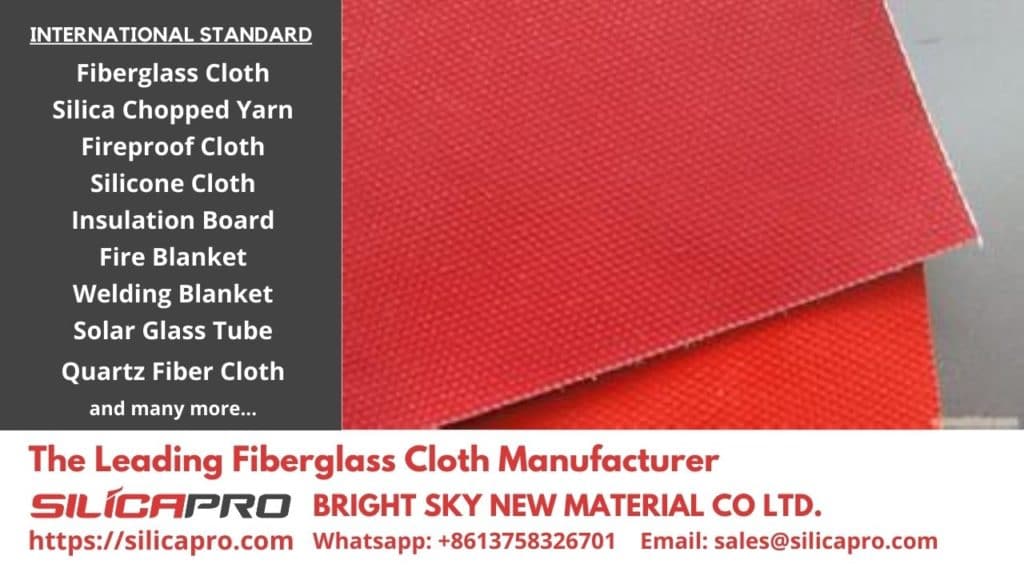
Fiberglass is becoming popular as a material because of its outstanding properties and characteristics. Fiberglass is one of the most commonly used thermal insulation materials. Thermal insulation materials or it can also be called insulation materials. Each insulation material has its characteristics and advantages.
Fiberglass has a high level of strength that can exceed the strength of alloy steel. The diameter of the fiberglass strand is about 7 to 9 microns, made of magnesium aluminosilicate glass and alkali-free glass. This composition makes fiberglass the highest strength. Fiberglass takes on the role of a reinforcing base.
Get a variety of fiberglass products through us, Silicapro. We are a supplier of unique high-silicon materials with high-temperature resistance features. And we have carried out product development in fiberglass coatings. Additionally, we provide a variety of fiberglass products to meet customer needs. All in all, we provide finished products fiberglass, high-temperature sewing thread, fireproof cloth, high silica chopped yarn, silicone cloth, nano-microporous insulation board, and high silica fiberglass cloth.
Our products actually have fairly good electrical insulation, high enough, and can withstand loads from relatively high voltages. Silicone Cloth can be converted into an insulationy cloth, casing, or also with other products. Another feature of this product is that it has an anti-corrosion aspect so that it can be used as a lining for pipes or internal and external storage tanks. Fiberglass has various types.
Contents
Types of Fiberglass Based on Its Shape
Fiberglass, as an insulating material, has many types. Variations of fiberglass based on its shape include:
Fiberglass Woven Fabrics
The glass fiber of the woven fabric is a reasonably strong reinforcement because the fibers are oriented in both directions and are bundled into yarn.
Fiberglass Tow and Roving
Fiberglass in tow or roving form is available in rolls that can be opened and cut as needed. Fiberglass Tow and Roving can also be incorporated into the filament winder. In this type, the fiberglass fiber must be maintained in tension to maintain its mechanical properties.
Fiberglass Chopped Strand Mat
Fiberglass chopped strand mat has moderate strength because the fiber length is relatively short. The Fiberglass Chopped Strand Mat is the most commonly used. In addition, this type also includes fiberglass at an affordable price. Fiberglass Chopped Strand Mat has a random fiber orientation with an effective concealed gel layer print. This fiberglass has a fiber length of 3 inches to 4 inches.
Fiberglass Veil Mats
Fiberglass veil mats have unbroken strands of fibers arranged in thin piles and looped randomly. It has a consistency similar to tissue paper. This type of fiberglass can be placed in a mold that is behind the surface layer.
The outer layer of the fiberglass hood mat is relatively very thin. The mat will be placed on top of the core in a direct position. The goal is to maintain the line thickness of the already ideal bond. The mat can also keep excess resin out. The goal is clear so that the resin does not fall into the nuclear cell (of course, when the vacuum is not used).
Fiberglass is the most commonly used insulating material. The manufacturing process by weaving fine strands of glass effectively so that it becomes an insulating material. Fiberglass, according to its shape, is divided into fiberglass woven fabrics, tow or roving, chopped strand mats, and veil mats have different characteristics.
It can minimize heat transfer made of finely woven silicone and glass powder. In conclusion, fiberglass is an insulating material that is not flammable and has an affordable price. However, in the installation, it is necessary to use protective equipment to maintain safety. Eye protection, masks, and gloves are the best equipment for handling fiberglass.

Basic Materials for Forming Fiberglass
Fiberglass is insulation materials consisting of various chemicals as the primary material to form fiberglass. The first chemical is resin, used as a mixture in the manufacture of fiberglass. Resin is a viscous liquid such as glue that serves to harden the fiberglass material according to the desired molding.
The following material is fiber or mat, the raw material used to make fiberglass cloth products with various specifications according to the woven shape. The mat is used for reinforcement and coating of fiberglass base mix mixtures.
The following material is erosil which acts as an adhesive for mat materials so that fiberglass has strength and is not quickly broken. The next ingredient is Talc, in the form of a white powder that resembles sago flour. Erosil serves to make fiberglass rigid but also flexible. The next ingredient is a catalyst that helps a dough retailer.
This catalyst is usually sold in a package with resin. The commonly used ratio between resin and catalyst is 1 to 1/40. For example, use 1 liter of resin, then a catalyst of 1/40 liter. The next ingredient is pigment, a coloring agent that makes the fiberglass material have the color you want.
Fiberglass Manufacturing Process
All the fiberglass-forming materials are melted and spun to manufacture the resulting fiberglass filament. There are two types of fiberglass filament: continuous filament and staple filament. Fiberglass is one of the most commonly used materials in the industry. It has properties that have many benefits. As insulation materials, fiberglass can be an excellent thermal and electrical insulation with good strength and long-lasting durability.
